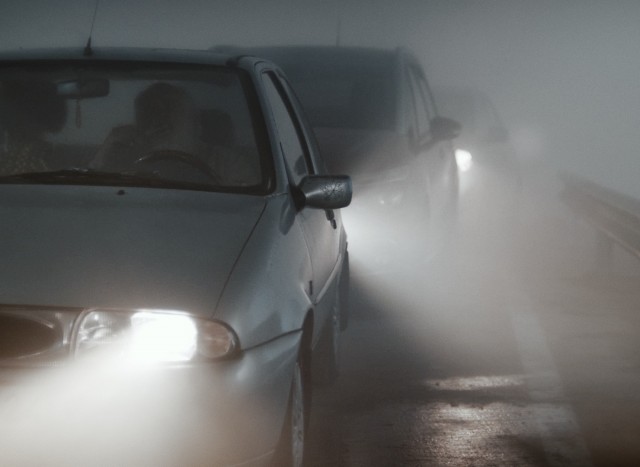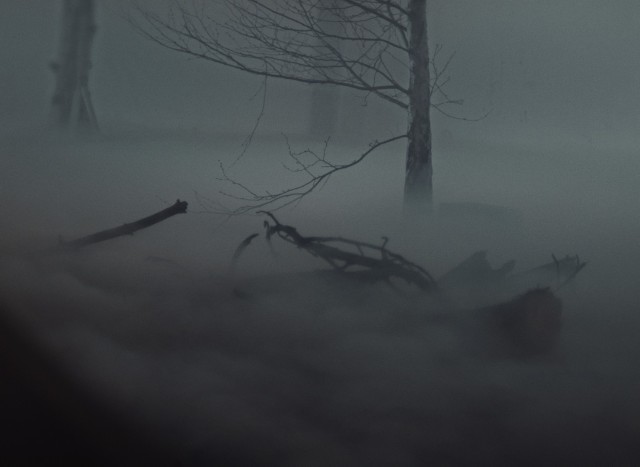Set on a highway encased in an ethereal fog, Wannes Vanspauwen’s 15-minute short film, De dag die wit was (The Day That Was White), avoids conventional storytelling, opting instead for a series of strange vignettes to tell its story of travellers trapped within this otherwordly mist. As families bicker and strangers try to get acquainted, we get a sense of the connection between these varied interactions, as Vanspauwen looks to explore an individual’s need for companionship and the role community plays in our lives.
The likes of Stephen King and John Carpenter have programmed us to be cautious of fog in storytelling, so when The Day That Was White first begins and we hear animalistic grunting emanating from the haze, the majority of us will experience an ominous tension. However, as Vanspauwen’s film evolves, we soon learn there is nothing to fear and as we eavesdrop on the conversations of those motorists stuck in the traffic jam, we realise this is very much a study of society and how we interact. Things do get a bit more sinister later in the film as an elderly man becomes disoriented in the smog. the sound design implying something threatening is circling him, but we soon return to the everyday conversations of the rest of the characters.

“What was remarkable wasn’t the congestion itself but the way people responded to it. They were out of their cars, setting up barbecues on the asphalt, laughing and connecting with strangers” – Vanspauwen discussing the incident that inspired his short.
The premise for The Day That Was White is one that has been maturing in Vanspauwen’s headspace ever since he was a child and he witnessed a similar traffic jam, which he describes as “creating an unexpected festival in the midst of chaos”. After experiencing this incident alongside his mother, it obviously left an impression on his young, impressionable mind as the filmmaker would use it, years later, as the seed from which his short would blossom. I’m sure that original congestion was not as picturesque and cinematic as the one in his short, but the curiosity around “how individuals respond to these unexpected incidents” remained.
“I was drawn to the idea of exploring how a single event – a misty traffic jam in this case – could serve as a catalyst for bringing together a motley crew of characters, each with their individual narratives but unified by a shared experience”, Vanspauwen explains. “It provided a unique canvas to delve into some of the complexities of the human condition, the unpredictability of life, and the shared threads of our existence. It’s fascinating to see how extraordinary circumstances can emerge from the ordinary, turning a mundane highway journey into an exploration of humanity.”
“Life is also about the nebulous ‘in-between’ – the foggy landscapes of our journeys”
The introduction of the fog to the film undoubtedly adds an extra dimension to Vanspauwen’s aesthetic, but it’s not just included as a visual gimmick, as the director had a particular metaphor he wanted to explore with its inclusion. Admitting that he often tends to view life as “a linear journey from one concrete milestone to another”, the director came to the realisation that life is more than just these “tangible endpoints”, looking instead to the “nebulous ‘in-between’ – the foggy landscapes of our journeys that lie between our known and our unknown” for answers.
“The fog in the film for me is this elusive ‘in-between’. It is a manifestation of our uncertainties, our doubts, and our fears, obscuring the concrete and making navigation through life’s highway challenging”, says Vanspauwen as we discuss his motivation for creating The Day That Was White. Before adding that he believes it is within this fog that “the truth of our existence lies” and in these unclear, undefined spaces that we “truly grapple with growth, and form connections”.

“To further enhance the realism of the scene, our art director sourced trees and a guardrail. These elements worked in concert with the lighting and fog to transport our set from an indoor hangar to a foggy, atmospheric highway.” – Vanspauwen on achieving the film’s impressive aesthetic
To create the film’s misty environment Vanspauwen toyed with many different techniques, including shooting outside in natural conditions. However, none quite achieved the look the filmmaker was aiming for, until he shot within a hanger containing several large fog machines. Looking to make the fog an important character, alongside his cast, within his narrative, the controlled environment allowed the director and his team total control over the intensity of the mist and location of lighting. “The breakthrough came when we decided to place lights directly into the mist”, the filmmaker admits. “The diffusion of light through the fog created an ambiance that perfectly embodied the feeling of uncertainty we were aiming to portray.”
It’s not just down to the visuals though, as Librecht Van Mechelen’s art design and Gus Bergans‘ sound work also play a vital role in the film’s success and the believability of the on-screen world. With the clever framing and ingenious use of lights from DoP Matthee Van Holderbeke combining with these elements to help ensure that you never feel like you’re in an internal location.
As the Managing Editor of Short of the Week and an advocate for the online viewing of short films, I don’t often discuss the downsides of watching work via the small screen, but two things crossed my mind after watching The Day That Was White: First, how much I would have loved to see it on a big screen and secondly, how urgently I wanted to discuss it with fellow film fans. There’s so much to unravel in Vanspauwen’s short, it feels like a piece I could continue to talk about in length – if you agree, feel free to let us know in the comments below, on our various social channels (we’re @shortoftheweek on most platforms) or on our Discord boards.

 Rob Munday
Rob Munday